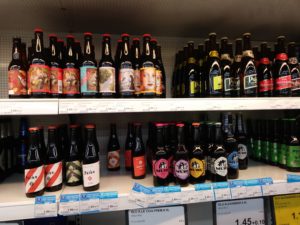After four nights by the beach, it was time for us to head off to the island of Saaremaa for a few more relaxing days. Our apartment in Kuressaare (I tried to convince Poppy to stay at the €7 a night campsite but she was having none of it) was roughly three hours from Pärnu by coach and ferry, the latter of which has a surprisingly good selection of local craft beers. There’s also a small bar near the port in Virtsu promising Tanker beers at €2 a pop, but unfortunately we didn’t get chance to check it out.
Our first full day was spent exploring the town, which is by far the biggest on Saaremaa with a population of around 14,000. It’s a pretty little place with plenty of interesting buildings and cosy places to eat, dominated by the 14th-century castle at the bottom of the main street. If Pärnu was notable for its abundance of statues, then Kuressaare must be staking a strong claim for the most petrol stations per capita. However, it was beer rather than unleaded we were after.

Martin and Irja from the bottle shop in Pärnu had given us two Saaremaa breweries to look out for: Pöide in the centre of Kuressaare, and Pihtla (Estonia’s oldest microbrewery, founded in 1990), which is based in a small village about 10 miles away. We looked into visiting both but unfortunately the former was only open to groups of 10 people or more, while the latter’s taproom only opens during the summer months (June-August), so we had to make do with sampling the beers in the local pubs.
Saaremaa Veski was our first port of call. This unique restaurant and bar located in an old windmill (veski means “mill”) had a really good selection of local brews, including both Pöide and Pihtla on draft and in bottles, as well as a selection from Muhu Brewery, located on the neighbouring island of the same name. We tried a few here including Pihtla Õlu (7.6%), my first ever example of an Estonian taluõlu (farmhouse beer). The funky, yeasty flavour wasn’t too dissimilar from a saison, but these beers are traditionally bittered with juniper rather than hops. Back in the UK I think they would call this real ale!

Meanwhile, the Pöide range was more Poppy’s cup of tea and she opted for a bottle of Schlager (5.2%), a Vienna lager that had the classic amber colour of the style, along with a nice maltiness and subtle hop bitterness.
Next we headed to John Bull Pub down by the harbour. Most of the beers here were from the Saku range, although there were a couple of bottled Pöide offerings available. I tried Kaamos (6.2%), a malty but ultimately fairly bland brown ale. Undoubtedly the highlight of this place is the garlic fried rye bread, which had so much garlic I could still taste it the morning after (that’s a good thing).

We had visited the fish restaurant at the Kuressaare Kuursaal for a delicious fish lunch the day before, but neglected to visit the Live & Be bar attached. We decided to put that right and were rewarded with a great selection of local beers, including some from another island brewery, Vormsi. Poppy tried their Lonks Päikest, a fairly strong lager at 5.7%, while I went for Muhu Täitsamees (5%), a tasty pale ale flavoured with juniper berries.
One thing we did notice about the local beers in all these places was that for whatever reason they seemed to cost considerably more than the international selection, around €5 per bottle. For those on a stricter budget, the Coop Rae Konsum supermarket just off the main square sells many of the same beers at around half the price. Having had enough of the bars, I decided to get a few more in to try from here to enjoy in the comfort of the apartment.

I’m in Kuressaare for the day, where should I visit? Saaremaa Veski had a good range of beers and the windmill was a fantastic and unique setting in which to enjoy them. The food looked great too – we didn’t try any but everyone else seemed to like it.
Brewery to look out for? None of the breweries were outstanding, but the Pihtla range of farmhouse-style beers was probably the most interesting.




